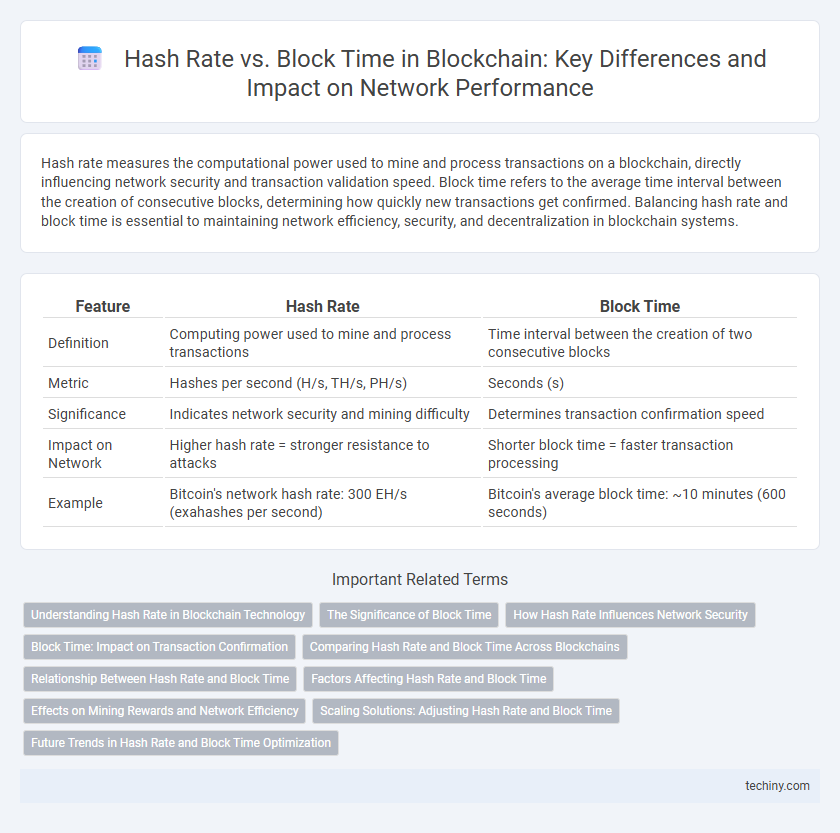Hash rate measures the computational power used to mine and process transactions on a blockchain, directly influencing network security and transaction validation speed. Block time refers to the average time interval between the creation of consecutive blocks, determining how quickly new transactions get confirmed. Balancing hash rate and block time is essential to maintaining network efficiency, security, and decentralization in blockchain systems.
Table of Comparison
| Feature | Hash Rate | Block Time |
|---|---|---|
| Definition | Computing power used to mine and process transactions | Time interval between the creation of two consecutive blocks |
| Metric | Hashes per second (H/s, TH/s, PH/s) | Seconds (s) |
| Significance | Indicates network security and mining difficulty | Determines transaction confirmation speed |
| Impact on Network | Higher hash rate = stronger resistance to attacks | Shorter block time = faster transaction processing |
| Example | Bitcoin's network hash rate: 300 EH/s (exahashes per second) | Bitcoin's average block time: ~10 minutes (600 seconds) |
Understanding Hash Rate in Blockchain Technology
Hash rate in blockchain technology measures the number of hash computations performed per second by a network's miners, directly impacting network security and transaction validation speed. Higher hash rates indicate greater computational power, enabling faster discovery of new blocks and enhancing resistance to attacks such as 51% attacks. Understanding hash rate is crucial for evaluating the efficiency and robustness of proof-of-work blockchains, where mining difficulty adjusts to maintain consistent block time intervals.
The Significance of Block Time
Block time is a critical metric in blockchain networks, representing the average time it takes to mine a new block and add it to the chain. It directly influences transaction confirmation speeds and network security, with shorter block times enabling faster transactions but increasing the risk of orphaned blocks. Maintaining an optimal block time balances decentralization, throughput, and resistance to attacks, ensuring the blockchain remains efficient and secure.
How Hash Rate Influences Network Security
Higher hash rate significantly enhances network security by increasing the computational power required to validate transactions and mine new blocks, making it more resistant to attacks such as 51% attacks. A robust hash rate ensures faster block verification times and maintains the integrity of the blockchain by preventing malicious actors from easily altering transaction history. Consequently, networks with elevated hash rates provide stronger decentralization and trustworthiness for users and participants.
Block Time: Impact on Transaction Confirmation
Block time directly influences transaction confirmation speed by determining how frequently new blocks are added to the blockchain, affecting overall network throughput and user experience. Shorter block times typically enable faster transaction confirmations, reducing latency and increasing efficiency for decentralized applications. However, extremely low block times can lead to increased orphaned blocks, compromising network security and consistency.
Comparing Hash Rate and Block Time Across Blockchains
Hash rate measures the computational power used by miners to secure a blockchain, directly impacting transaction processing speed and network security. Block time refers to the average duration required to mine a new block, varying significantly across blockchains such as Bitcoin (approximately 10 minutes) and Ethereum (around 13 seconds). High hash rates combined with low block times generally indicate a more secure and efficient blockchain, but the trade-off between these metrics affects scalability and energy consumption differently across networks.
Relationship Between Hash Rate and Block Time
The hash rate directly influences block time by determining the network's processing power to solve cryptographic puzzles, affecting how quickly blocks are added to the blockchain. An increase in hash rate generally reduces block time, enabling faster transaction confirmations, while a decrease in hash rate lengthens block intervals. This dynamic balance is crucial for maintaining the targeted block time and ensuring network stability and security.
Factors Affecting Hash Rate and Block Time
Hash rate and block time in blockchain are influenced by network difficulty, mining power, and consensus algorithms, with higher hash rates generally leading to faster block times. Variations in network difficulty adjust the computational effort required, thereby balancing the block generation rate despite fluctuating hash power. Latency, hardware efficiency, and protocol updates also critically affect the synchronization of block production and security within the blockchain network.
Effects on Mining Rewards and Network Efficiency
Hash rate directly influences mining rewards by determining the speed at which new blocks are solved, with higher hash rates increasing the likelihood of earning rewards. Block time, the average interval between new blocks, impacts network efficiency by balancing transaction confirmation speed and the risk of orphaned blocks. Optimal alignment of hash rate and block time enhances overall blockchain security and mining profitability while maintaining efficient transaction processing.
Scaling Solutions: Adjusting Hash Rate and Block Time
Scaling solutions in blockchain often involve adjusting hash rate and block time to improve network efficiency and transaction throughput. Increasing hash rate enhances mining power, reducing the risk of centralization while maintaining security, whereas optimizing block time balances faster transaction confirmation with network stability. Layer 2 protocols and sharding complement these adjustments by enabling higher scalability without compromising decentralization.
Future Trends in Hash Rate and Block Time Optimization
Future trends in hash rate emphasize continuous growth driven by advancements in mining hardware efficiency and expanding network participation, which enhance overall blockchain security. Innovations in consensus algorithms and protocol upgrades aim to optimize block time by reducing latency and increasing transaction throughput, balancing speed with decentralization. Emerging technologies such as AI-powered mining optimization and adaptive difficulty adjustment mechanisms are expected to further refine the synchronization between hash rate and block time for scalable blockchain performance.
Hash Rate vs Block Time Infographic

 techiny.com
techiny.com